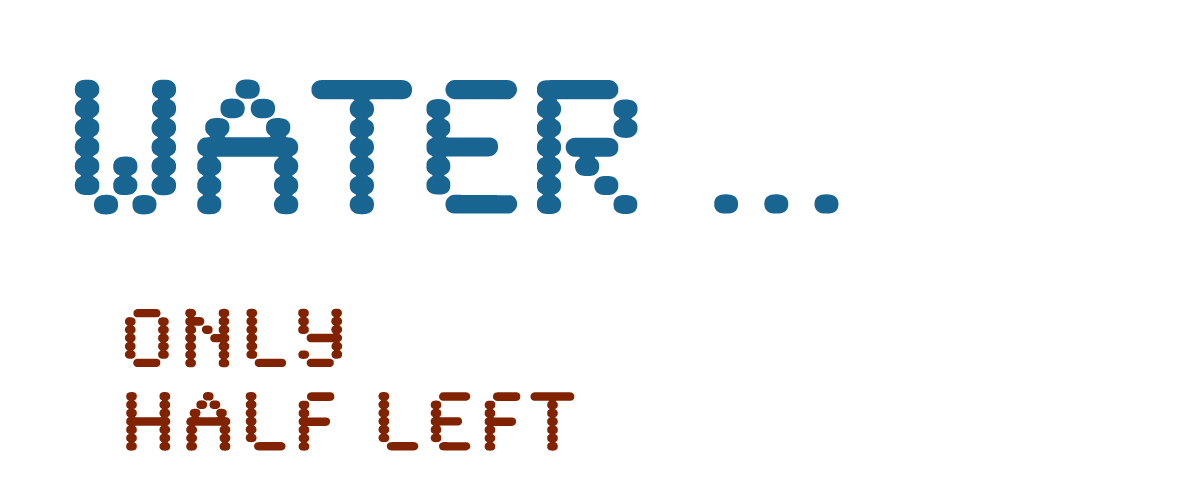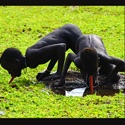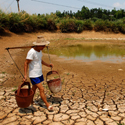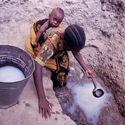Warming May Cause Widespread Water Shortages, Studies S
Brian Vastag
for National Geographic News
November 21, 2005
Even as the ice caps melt, global warming threatens to leave a billion people high and dry, says a team of U.S. climate scientists.
If the Earth warms just a degree or two Celsius in coming decades, regions that depend on runoff from mountain snows for drinking water and farming will face shortages, according to a study published in the November 17 issue of the journal Nature.
A companion article supports the claim, showing that mountain runoff has already decreased in some regions of the world.
“We found that, no surprise, less snow falls in a warmer world,” said Timothy Barnett of the Scripps Institute of Oceanography in La Jolla, California. “And what snow there is melts earlier.”
The two factors combine to push peak runoff from summer into spring, when reservoirs are already at capacity.
“The dams get filled earlier in the year, and they can only be filled to a certain level, so there’s still some flood control,” Barnett said.
The result: Much of the early runoff goes to waste, prompting shortages in late summer and autumn.
“It’s like squeezing six months of snowmelt into four,” Barnett said.
A Billion Dry
To develop their climate model, which looks ahead 30 to 40 years, Barnett and Jenny Adam of the University of Washington in Seattle looked at 30 years of global precipitation records.
They mapped the globe into squares and calculated how much precipitation fell in each square as rain and how much as snow. They overlaid that data onto a map of regions that depend on snow for at least 50 percent of their water supply, including the western United States.
“In California, Mother Nature holds the snow for us up in the Sierras,” Barnett said. “It’s basically a massive reservoir.”
Adams then researched manmade reservoirs in the target regions and found that the vast majority do not have the capacity to store the extra, early runoff.
“We were surprised how many places [lacked extra capacity]“, Barnett said. “[Reservoirs] were built on the assumption that ├óÔé¼┬ª water availability throughout the year wouldn’t change.”
In addition to the western United States and Canada, hard-hit regions include parts of Europe, South America west of the Andes, and much of central Asia from northern India across to China and Russia.
About one-sixth of the world’s population├óÔé¼ÔÇØmore than a billion people├óÔé¼ÔÇØinhabit these areas. The regions at risk also account for about a quarter of the world’s economic output.
“What are those people going to do?” Barnett asked. “Just sit there and be thirsty and watch their crops die?”
Less Runoff
Christopher Milly, a hydrologist with the U.S. Geological Survey, said that Barnett and Adam’s model draws on two decades of “really robust” research.
But climate scientists are less confident in predicting how, rather than where, global warming will affect total annual precipitation and river flow.
In a companion article in Nature, Milly used historical data from a dozen climate models to make a composite that accurately predicted changes in 20th century river flow across the globe.
Extending the model into the future, he estimated that by 2050 the western U.S., southern Africa, and areas surrounding the Mediterranean Sea will receive 10 to 30 percent less runoff than they currently do.
“Our contribution has been to show that the models ├óÔé¼┬ª can match observations of trends in water availability,” Milly said of his study.
Add this shortage to a shift in peak runoff from summer to spring, and the potential for crisis looms, warns Barnett.
As an example, he points to the Klamath River in northern California and Oregon. In 2001 the river ran about 25 percent lower than normal, leading to a tussle between conservationists and farmers over the water that remained. A court ruling led to a release of water to save two endangered species of sucker fish.
But in 2002, when the river ran low again, the farmers won and salmon lost. As water was diverted to agriculture, thousands of salmon died, perhaps as much as half of the river’s spawning population, according to the Oregon Natural Resources Council.
More difficult water choices loom, Barnett says.
“The Klamath situation is a harbinger of things to come,” he said. “You can see the whole future sort of happening right there.”




